August 6 will soon arrive again this year.
Needless to say, August 6 is a very special day in Hiroshima, and many citizens of Hiroshima greet this day with a sense of prayer.
If I may speak personally, my mother was exposed to the atomic bombing, although not directly (she entered the city the next day).
My mother was working 2 km from the hypocenter at the time, but she happened to be sick that day and took the day off from work to stay at her parents’ house far from the center of the city. Thanks to that, my mother survived and I was born after that.
If I had taken a different step, I would not have existed, and I, too, greet and spend August 6 with various thoughts and feelings.
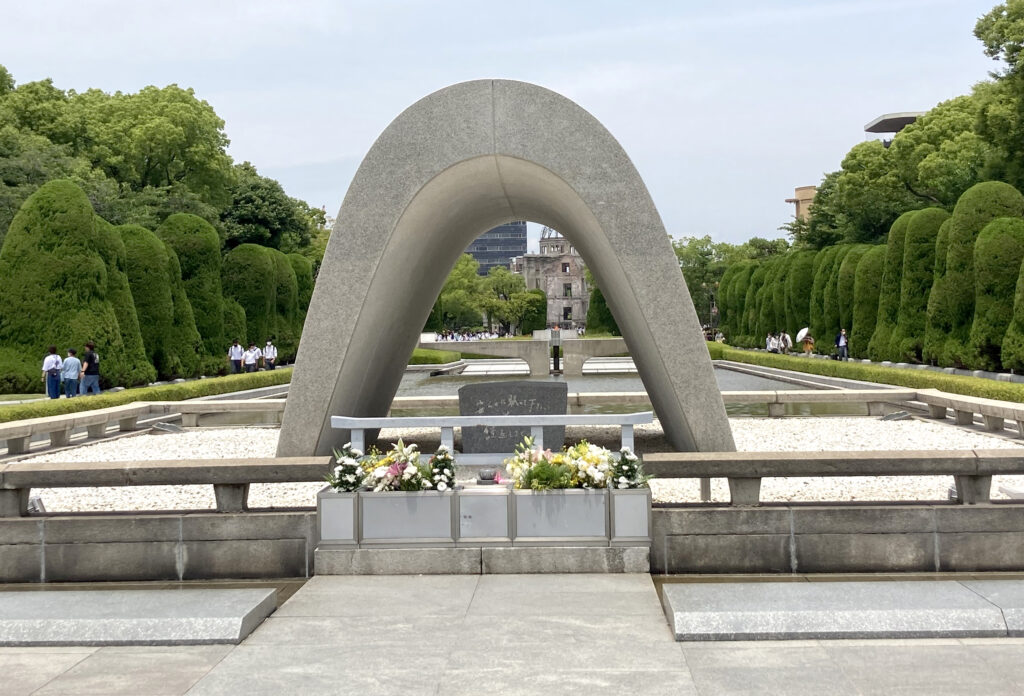
Here in Hiroshima Peace Memorial Park, the center of prayer, there is the Atomic Bomb Dome, Peace Memorial Museum, and other major facilities, but there are also numerous cenotaphs, memorial towers, and statues of memorials.
This article introduces the cenotaphs, memorial towers, and statues in the park with maps and photos. The map is hand-drawn, so it omits detailed paths, etc., but you should be able to get a general idea of the locations.
In the latter half of the map, we will also include photos and descriptions of the main facilities.
(We apologize that some of the text is not yet complete. We will add them as we go along.)
There are many cenotaphs and memorial towers in the park. I would be happy if you could visit them.
Map of Hiroshima Peace Memorial Park
First, please take a look at the overall map. The circled numbers from 1 to 57 are the locations of the monuments and statues. Because of the large number of monuments and statues, the map is divided into 7 areas from A to G.
The links below the map will take you to the list of each area. You can also return to the map by clicking on the “Return to Map” button along the way.
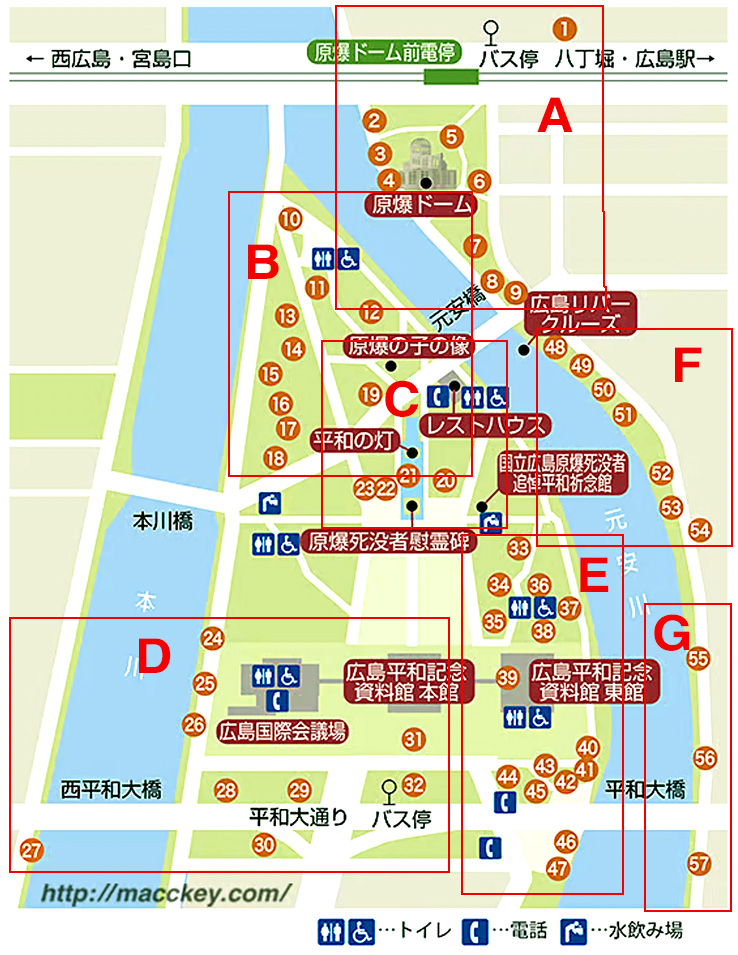
You can jump directly to the list of each area from the links below.
B To the area west of the Statue of the Children of the Atomic Bomb
C Cenotaph for the Atomic Bomb Victims and Surrounding Area
E East Wing of Hiroshima Peace Memorial Museum and surrounding area
F East bank of Motoyasu River 1 (south side ofMotoyasu Bridge) To area
Cenotaphs, memorial towers, and statues in Areas A to G are listed by area.
A Atomic Bomb Dome Area
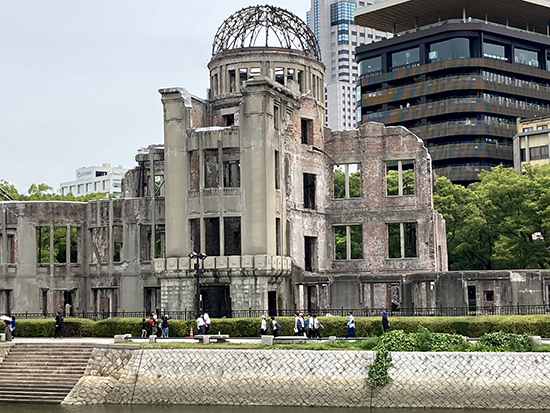
1 World Children’s Peace Statue
2 Miekichi Suzuki Literature Monument 3 Aioi Bridge Monument
4 Monument to the Death of Chugoku Shikoku Civil Engineering Sub-branch Office Employees
5 Cenotaph for Hiroshima Prefecture Regional Lumber Control Co.
6 Hara Tamiki Poem Monument (Chronicle of Haruo Sato’s Poem Monument)
7 Cenotaph for mobilized students 8 Hiroshima City Road Marker 9 Flower Clock
1 World Children’s Peace Statue
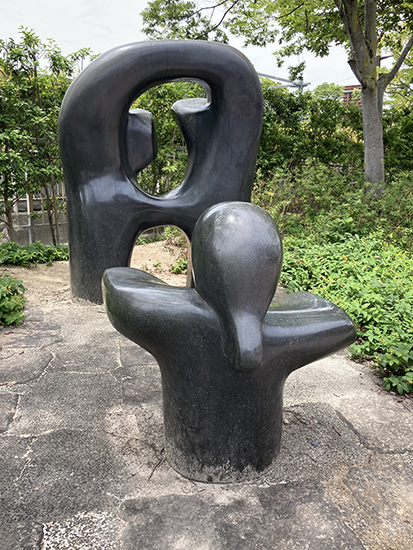
The monument was built on August 6, 2001 by high school students in Hiroshima, including members of the High School Peace Seminar. It is an image of two adults holding hands and a child running up to them. It is located in front of the former Hiroshima Municipal Baseball Stadium across the street on the north side of Densha Dori.
2 Miekichi Suzuki Literature Monument

This is a monument to Miekichi Suzuki, a Hiroshima-born author of children’s literature and the head of the literary magazine “Akai Tori” (Red Bird). Along with his bust, the right pedestal reads “I have a dream forever. I have a dream forever, just like when I was a child. I am only as young as I was when I was a child, and I am only as shallow as I am troubled. Miekichi” is inscribed on the monument. It was built in June 1964 as a symbol of the restoration of Hiroshima culture. It is located at the east end of Aioi Bridge.
3 Old Aioi Bridge Monument

The Aioi Bridge was built in 1932 and is an unusual T-shaped bridge. This T-shape made it easy to see from the sky, and this was chosen as the target of the atomic bombing. The actual hypocenter was about 300 meters away over the “Island Hospital,” but the Aioi Bridge was also severely damaged. The Aioi Bridge is located a short distance from the bridge in the green area of Peace Memorial Park.
4 Monument to the Death of Chugoku Shikoku Civil Engineering Sub-branch Office Employees
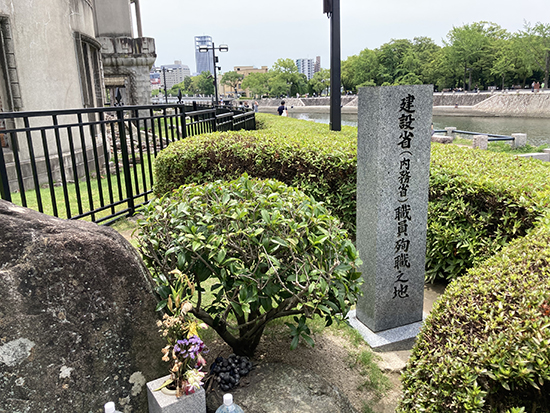
The Chugoku-Shikoku Civil Engineering Sub-branch of the Ministry of Construction (Ministry of Home Affairs), which had an office in the Hiroshima Prefectural Industrial Promotion Hall, was severely damaged, with 52 employees killed and 9 injured out of 93 employees. The monument was erected in 1947 in wood, and was replaced in 1954 with a monument in natural stone.
5 Cenotaph for Hiroshima Prefecture Lumber Control Co.
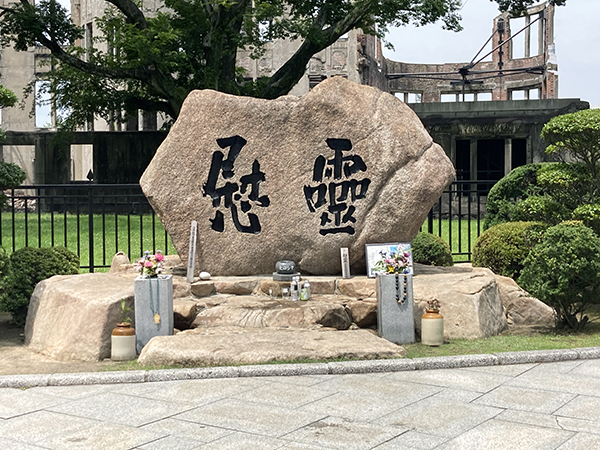
At the time, Hiroshima Prefecture Lumber Control Co., Ltd. had its headquarters in the Hiroshima Prefectural Industrial Promotion Hall, where 260 employees worked. More than 100 executives and employees were exposed to the atomic bomb and died in the blast. The cenotaph is a large natural stone with the word “Memorial” on the front and an inscription on the back. It is located northeast of the A-bomb Dome.
6 Hara Tamiki Poem Monument (inscription on poem by Haruo Sato)
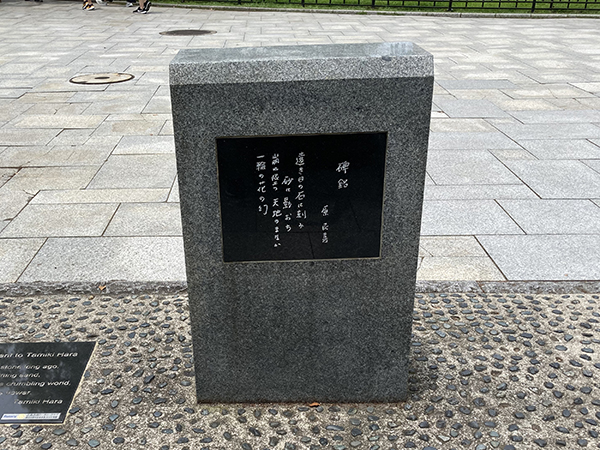
The poet Tamiki Hara was exposed to the atomic bombing at the age of 40 at his birthplace in Noboricho. The year before, his beloved wife had died, leaving him in solitude, but he continued to write works that conveyed the horrors of the atomic bombing as part of his mission as a survivor. On the front of the monument is a manuscript of a poem written by Tamiki himself, and on the back is an inscription written by his friend and writer Haruo Sato.
7 Memorial to mobilized students
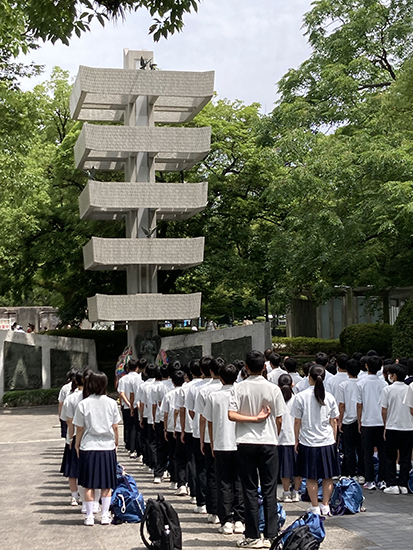
During World War II, students of junior high school age and above were mobilized and forced to perform labor service. On the day of the atomic bombing, about 6,300 of the more than 8,200 students from the National High School and above who were doing labor service in Hiroshima were killed. On the day I took this picture, a group of high school students who seemed to be about the same age as me were listening to a story in front of the monument, and I wonder what they all thought…
8 Hiroshima City Road Marker
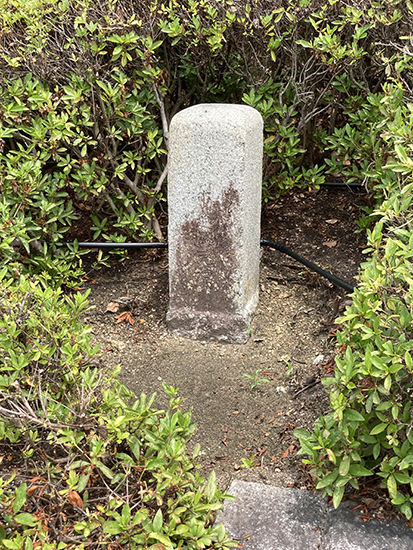
This road marker is located quietly in the middle of the plantation on the north side of the east end of Motoyasu Bridge. In the past, this area was a strategic point for land transportation, and the distance from Hiroshima was measured from this point. The original marker, which was once a wooden pole, was replaced by a stone pole when the city of Hiroshima was incorporated in 1889. The corners are missing due to the intense heat.
9 Flower Clock
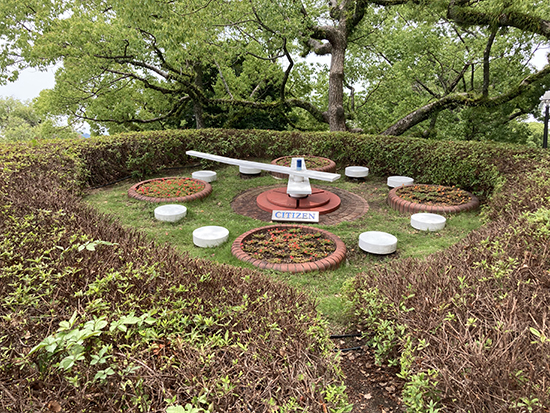
The flower clock was installed on the south side of the Public Hall (now the International Conference Center) in June 1973 as a symbol of the wish for peace, but was later relocated to the north side of the east corner of the current Motoyasu Bridge in May 1992, following the construction of the Hiroshima International Conference Center. The clock is located in a planted area, and the angle of the clock plate is shallow, so it may be a little difficult for walkers to read the time.
B Statue of the Children of the Atomic Bomb (west side)
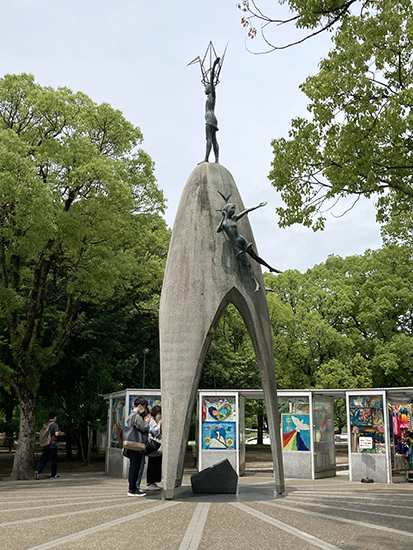
10 Peace Clock Tower 11 Peace Bell
12 Stone Mound for Peace 13 Memorial Pagoda for the Victims of the Bombing
14 Atomic Bomb Memorial 15 Stone Lantern for Peace
16 Cenotaph for Korean A-bomb Victims
17 Tombstone of A-bomb victims (Tombstone at the site of Jisenji Temple)
18 Peace Kannon statue 19 Prayer statue
10 Peace Clock Tower
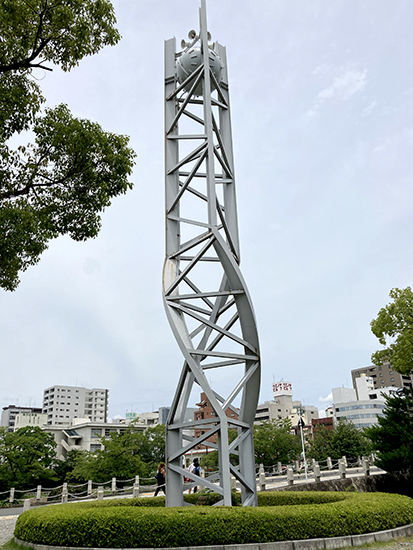
Erected and donated by the Hiroshima Koijo Lions Club on October 28, 1967. On top of a 20-meter-high iron pillar with a distinctive twist, there is a 2-meter-diameter sphere symbolizing humanity, with clocks in three directions. At 8:15 a.m., the time of the atomic bombing, a chime sounds, appealing for world peace and No More Hiroshimas.
11 Peace Bell
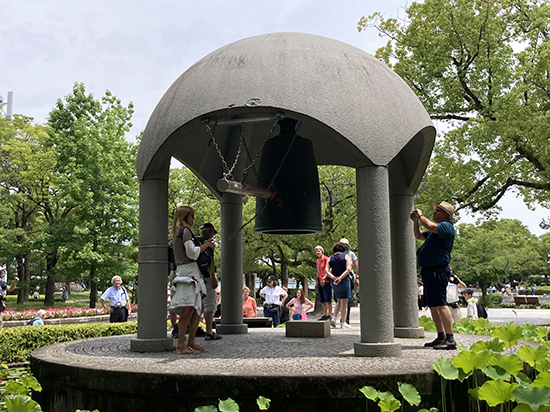
This bell is the work of Masahiko Katori, a holder of the Important Intangible Cultural Property (Living National Treasure) for bell making. The bell was installed as a symbol of a world without nuclear weapons and without war, where people can live together in peace. Anyone can toll the bell, but since it is a precious bell, the following two precautions are recommended: (1) do not toll the bell with excessive force, and (2) do not toll the bell again while it is still reverberating.
12 Peace Stone Mound
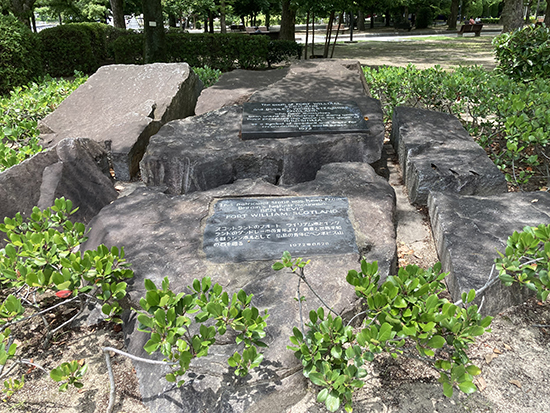
This stone mound is a gift from the cities of Fort William (Scotland) and Dudley (England) after the Junior Chamber of Commerce Hiroshima sent a plaque to Mount Ben Nevis, which was considered a mountain of peace in the United Kingdom after World War II. The design represents the seven rivers of Hiroshima with granite.
13 Memorial Pagoda for those who died in distress
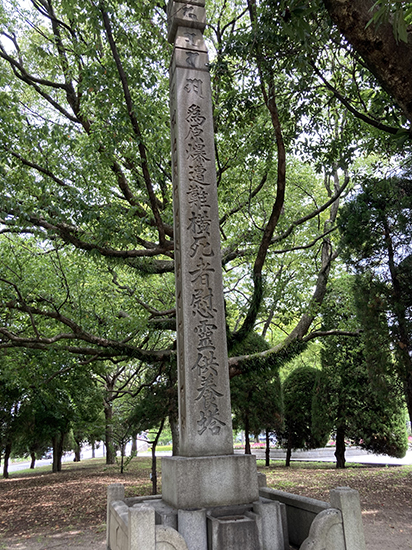
This memorial tower was erected in 1957 by the Shingon sect believers in Hiroshima Prefecture. It stands a little north of the A-bomb memorial tower, among the trees. Although it is written in Sanskrit and cannot be read, it is said to contain a prayer meaning, “War is caused by the confusion and ignorance of people’s hearts, so peace will come when we know the truth.
14 Atomic Bomb Memorial Tower
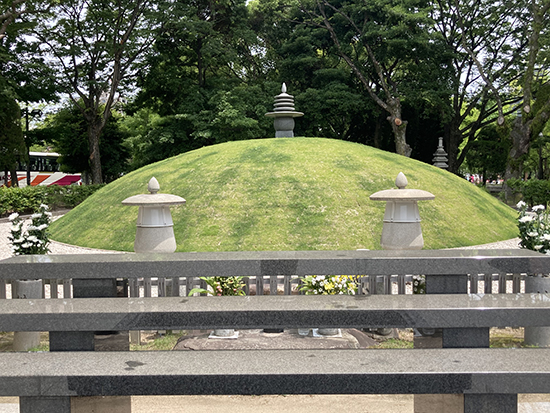
It is said that countless bodies were brought to this place near the hypocenter and cremated at that time. In 1946, a temporary memorial tower and ossuary were built here with donations from citizens, and in 1955, the city of Hiroshima reconstructed it into the present memorial tower. The ossuary inside contains approximately 70,000 unclaimed remains, and a search is still underway for the families of the deceased.
15 Peace Stone Lantern
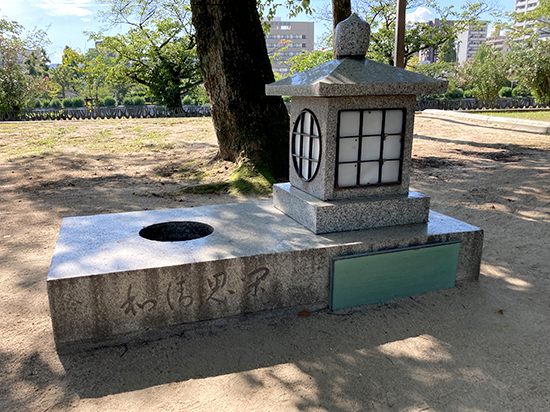
This stone lantern was erected in 1955 by the Hiroshima branch of the Tankokai, the Urasenke school of tea ceremony, to pray for the repose of the souls of the victims. The stone is shaped like a tatami mat, with a furnace and lantern on top of it, to express the meaning that “on the tatami mat, masters and guests are equal and there is no discrimination. Every year on August 6, a tea ceremony is held in front of the stone lantern, where people offer their palms in prayer and offer a tea service.
16 Cenotaph for Korean Atomic Bomb Victims
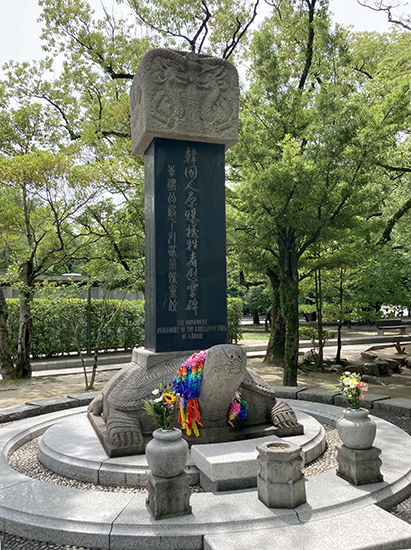
It is said that tens of thousands of Koreans were exposed to the atomic bombing in Hiroshima City at that time. The Korean Cenotaph Erecting Committee erected this cenotaph to commemorate the victims and to prevent the repetition of this tragedy. It has a pedestal in the shape of a turtle, a monumental pillar on top of it, and a crown with twin dragons carved on it.
17 Gravestone of the A-bombed (Tombstone at the site of Jisenji Temple)
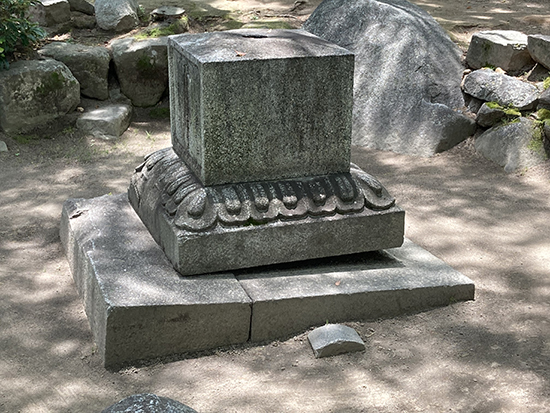
Jisenji Temple, a large temple located here, was also destroyed, and all of its priests and other members of the temple were killed. The temple was also used as a branch school for the National School of Japan, and more than a dozen children who commuted to the school were killed. While many of the gravestones on the temple grounds were blown away by the powerful blast, this grave remains as it was at the time of the bombing.
18 Heiwa-no-Kannon statue
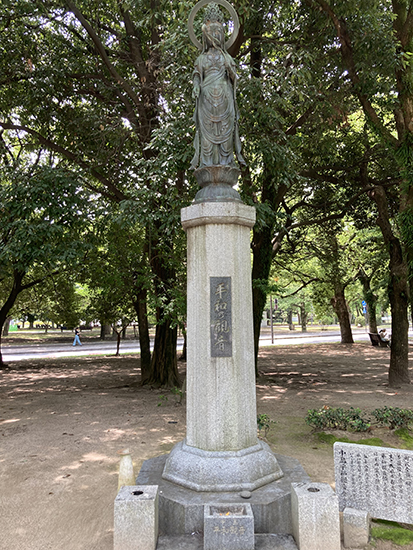
There used to be a town called Nakajima Honmachi in this area, which was very prosperous with a shopping district and a movie theater. The town was destroyed by the atomic bomb and its residents were almost completely wiped out. After the war, the town itself disappeared as it was turned into a park. The statue of Heiwa-no-Kannon was erected by the former residents of Nakajimahonmachi to express their regret for the loss of the town and as a memorial to the victims.
19 Prayer Statue
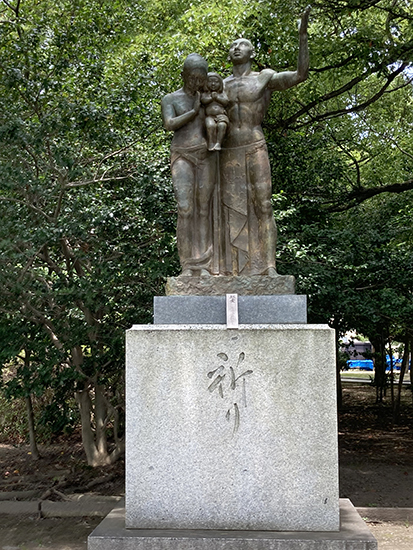
The Prayer Statue was erected in 1960 and was created by sculptor Yoshizumi Yokoe. It is a bronze statue of a young couple holding a child. The statue commemorates those who died for their country during World War II and many other hardships. In front of the pedestal on the right is a poem by Atsuo Ohki, a poet from Hiroshima, entitled “Pray for Peace and Pacify the Souls of the Dead.
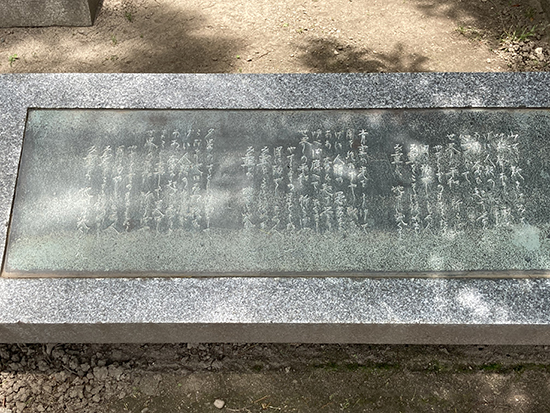
C Cenotaph for the Atomic Bomb Victims and Surrounding Area
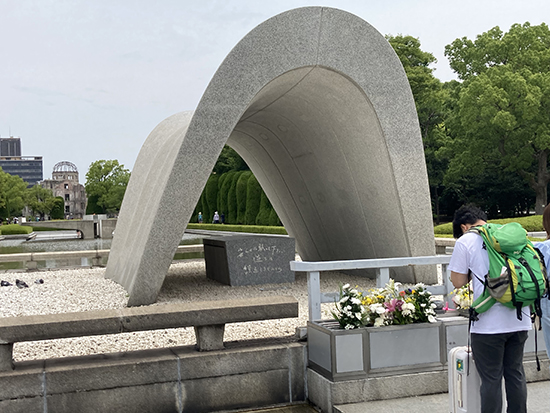
20 Peace Statue (Poem by Shimpei Kusano) 21 Peace Pond
22 Peace Fountain
23 Bodhi Tree Monument
20 Peace Statue (Poem by Shinpei Kusano)
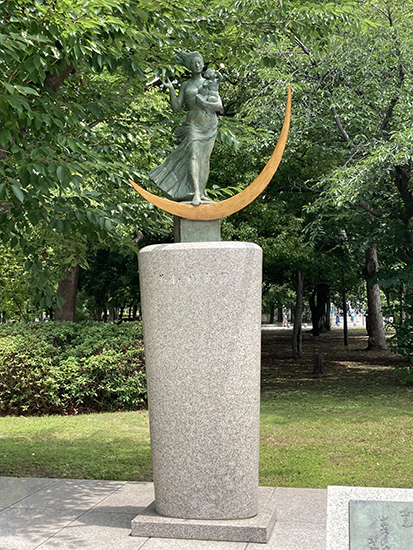
The statue depicts a mother, a baby playing the trumpet, and a crescent moon. The sculptor, Katsuzo Entsuba, a native of Hiroshima, created the statue with the message “From parents to children, from yesterday to tomorrow, the crescent moon will soon be full. The crescent moon will soon become a full moon. I want to sound the trumpet of peace in search of a new future. Beside the statue, there is a monument to the poet Shinpei Kusano, who contributed a poem to the statue.
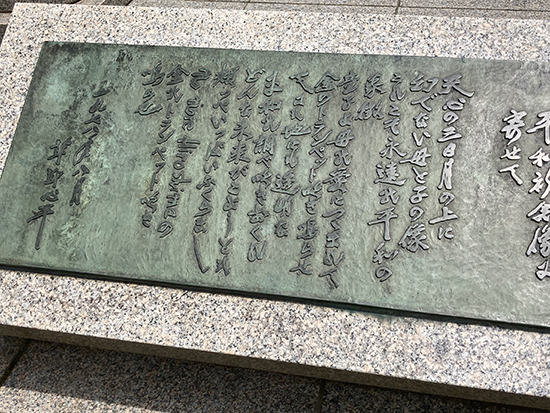
21 Peace Pond
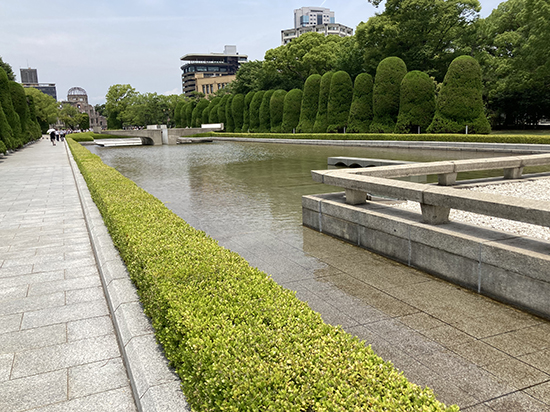
The Peace Pond was constructed by the Junior Chamber of Japan as a commemorative project for the 5th Junior Chamber of Japan Membership Convention held in Hiroshima in 1957. The pond was designed to surround the Cenotaph for the Atomic Bomb Victims on three sides so that the monument would float in the water, and was expanded in 1964 when the “Peace Lights” were installed, and is now 17 m wide and 70 m long.
22 Peace Fountain
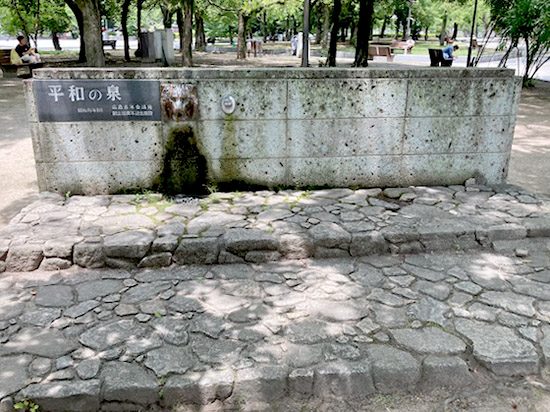
The Peace Fountain is a 1 m high, 4 m wide wall of Oya stone. There is a lion made of ceramic on the far left, and water flows from its mouth when a button next to it is pressed. The purpose of the water is to allow people traveling to actually drink, and also to remember the many people who suffered for water during the atomic bombing.
23 Bodhi Tree Monument
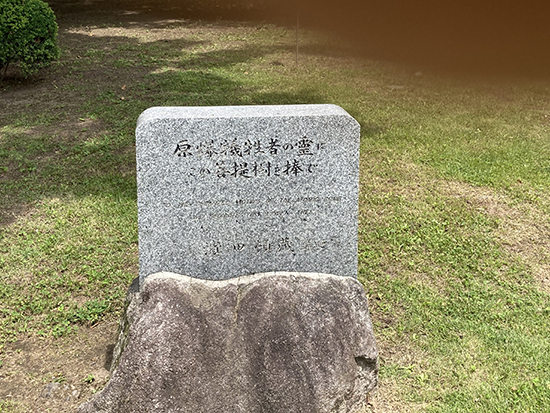
Although the details are not clear from the Hiroshima City data, it seems that this monument was erected on February 6, 1959, when a man named Hamada Tonzo planted a Bodaiju tree to comfort the victims of the atomic bombing. The inscription reads, “This Bodhi tree is dedicated to the spirits of the victims of the atomic bombing.(Ilooked at it a lot when I took this picture, but I was not sure which tree was the Bodhi tree. I think it is the tree behind the monument in this photo, by the flagstaff.)
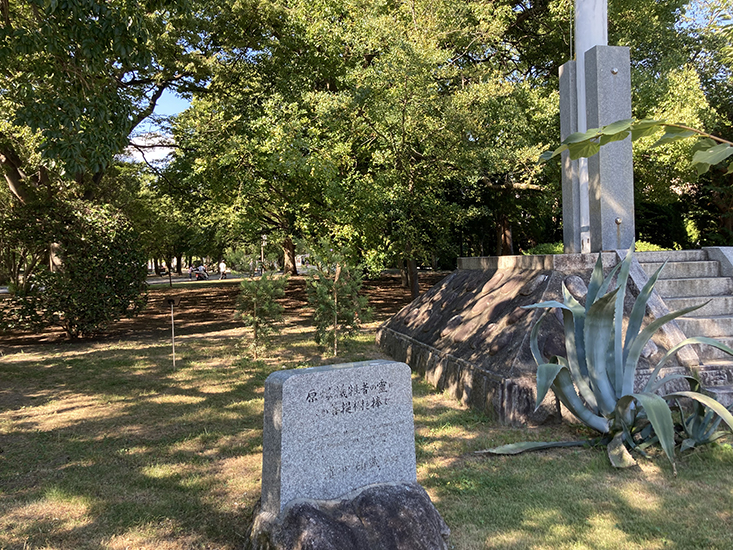
D. Main building of Hiroshima Peace Memorial Museum, Hiroshima International Conference Center and its vicinity
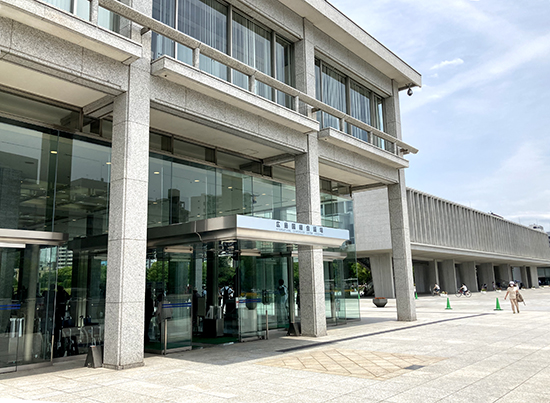
24 Monument to the Volunteer Corps 25 Cenotaph for the A-bomb Victims of Hiroshima Second Middle School
26 Cenotaph for Hiroshima Municipal School of Commerce and Shipbuilding Industry
27 Statue of the Mother of Mercy
28 Monument to National School Teachers and Children Victims of the Atomic Bomb
29 Peace Statue “Wakaba” (monument to Hideki Yukawa’s poem)
30 Monument of Friendship 31 Prayer Fountain
32 Statue of Mother and Child in the Storm
24 Monument of Volunteer Corps
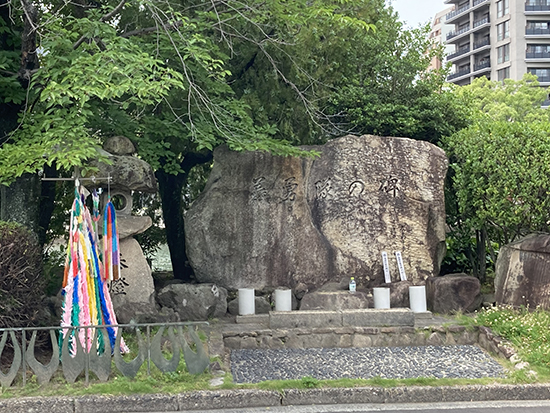
In 1945, under the Volunteer Service Law, boys aged 15 to 60 and girls aged 17 to 40 were designated as “volunteer corps” and engaged in building evacuation work. At the time of the atomic bombing, all 200 members of the volunteer corps in Kawauchi Village, who were working near Nakajima Shinmachi, were killed, including 180 victims in the Onui area. This monument was erected by the bereaved families of the Onui area to convey the horror of the atomic bombing and the noble sacrifices of the volunteer corps members, and to emphasize the preciousness of peace.
25 Hiroshima Second Middle School Cenotaph for the A-bomb Victims
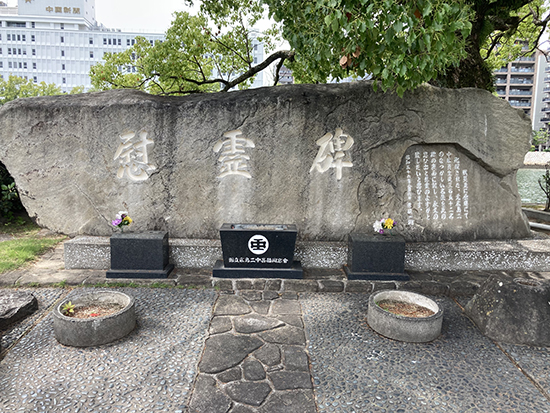
321 first-year students and four teachers from the former Hiroshima Second Middle School (now Hiroshima Kannon High School) were exposed to the atomic bomb while engaged in building evacuation work in Nakajima Shinmachi. It seems that all of them were killed almost instantly at 600 meters from the hypocenter. The names of all of them are inscribed on the reverse side of the monument. In addition, the “Memorial Poem Monument,” erected on August 6, 1953, stands next to this monument.
26 Cenotaph for Hiroshima Municipal Commercial and Shipbuilding Industrial School

Hiroshima Municipal Commercial School (now Hiroshima Municipal Commercial High School) was converted to Municipal Shipbuilding and Industrial School by national policy at the end of the war. At the time of the atomic bombing, 195 first-year students and five staff members were evacuating buildings near Zaimoku-cho Shogan-ji Temple, 500 meters from the hypocenter, and all but one of them went to the hospital on the way to the bombing site, where they died. This monument was erected to pray for the repose of the souls of the students and staff and to vow that the tragedy will never be repeated.
27 Statue of Jibo
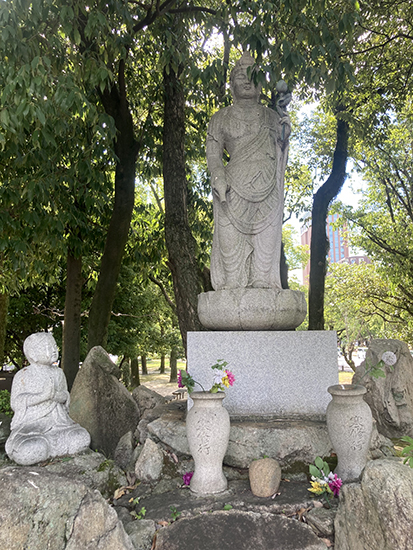
The Statue of the Mother of Mercy was single-handedly erected in 1961 by Mr. Takanobu, who owned the long-established toy store “Marutaka Children’s Department Store” in Hiroshima. Mrs. Taka, who lost her husband and child in the atomic bombing, erected the statue at the location where her store was originally located, so that her grief and tragedy would not be forgotten. The Kannon statue stands quietly at a distance from Peace Park.
28 Monument to National School Teachers and Children Victims of the Atomic Bombing
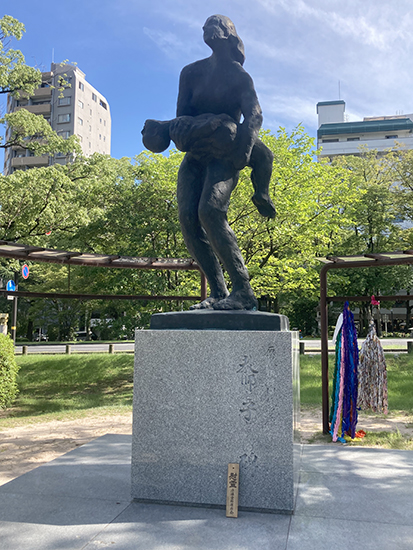
As the war intensified, children above the third grade of elementary school (today’s third grade of elementary school) were forcibly evacuated from the area. The statue, depicting a bedraggled child and a female teacher who was herself exposed to the atomic bombing, strikes a chord in the hearts of those who see it. The inscription includes a tanka poem by Shinoe Shoda, an A-bombed poet.
29 Statue of Peace “Wakaba” (poem by Hideki Yukawa)
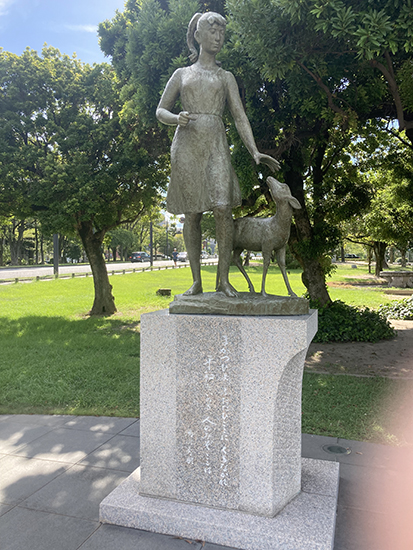
This fresh work, by Entsubaki Katsuzo, a sculptor from Hiroshima, depicts a young girl and a fawn looking up at her. It is inscribed with an inscription by Dr. Hideki Yukawa: “Magatsubi yo, don’t come back here again, only those who seek peace can come here. Magatsubi is a god that causes disasters. Dr. Yukawa felt responsible for the atomic bombing as a scientist.
30. Friendship Monument
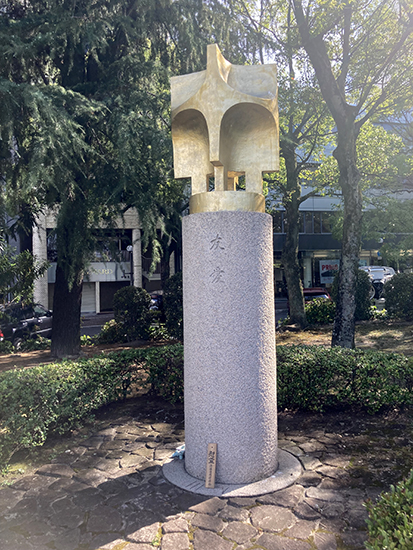
The Friendship Monument was erected in 1965 by the Hiroshima District Committee of the General Insurance Association of Japan. Many employees of non-life insurance companies were also victims of the atomic bombing, and this work is a memorial to them and a symbol of the love and conscience of people around the world who wish for peace. The cross shape of the sculpture represents people from the east, west, south, and north holding hands.
30 Prayer Fountain
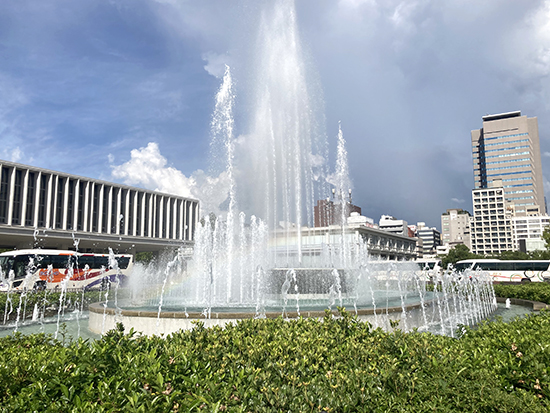
The Prayer Fountain is a large fountain pond located in the plaza to the south of the main Peace Memorial Museum building. It is now one of the symbols of the entire Peace Park. It was installed in 1958 as a memorial to the A-bomb survivors, who died saying “water, water” in their mouths. It is circular in shape, measuring 27 m east to west and 19 m north to south, and the height of the water is approximately 4 m.
31 Statue of a Mother and Child in a Storm
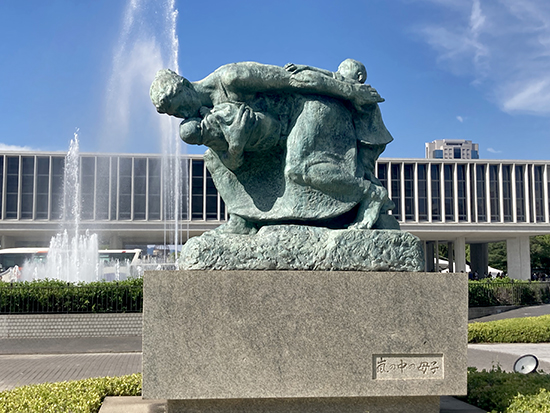
This work by Arata Hongo depicts a mother holding her baby and carrying her child on her back, trying to move forward strongly in the midst of a storm. The original plaster statue was presented to the Mayor of Hiroshima by the Japan Council against Atomic and Hydrogen Bombs on the occasion of the 5th World Conference Against Atomic and Hydrogen Bombs in 1959, and later became a bronze statue through the efforts of the Hiroshima City Women’s Association. The strong love of the mother is combined with the wish for peace of the citizens of Hiroshima.
E. East Wing of Hiroshima Peace Memorial Museum and Surrounding Area
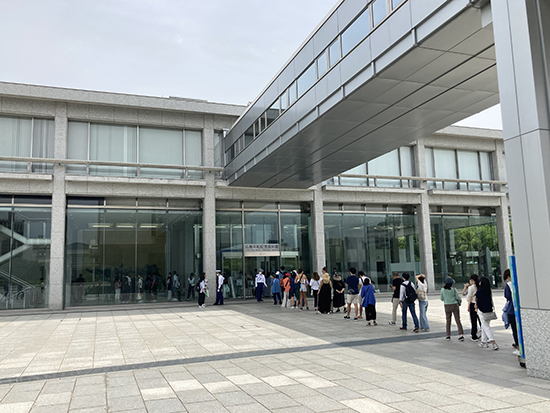
33 Cenotaph for the former Tenjinmachi Kita-gumi 34 Monument for the former Lumber Town
35 Hamayu, the A-bomb victim 36 Monument to Sankichi Toge
37 Monument of Total Loss of Life 38 Aogiri, A-bombed
39 Monument of Pope’s Appeal for Peace
40 Clock commemorating the return of the Democratic People’s Republic of Korea
41 Monument to Norman Cousins
42 Monument to Dr. Marcel Junod
43 Monument in memory of Barbara Reynolds
44 Peace Memorial Post 45 Peace Tower
46 Hiroshima Municipal High School for Girls Cenotaph for the A-bomb Victims
47 Cenotaph for the former Tenjincho Minamigumi
33 Cenotaph for the former Tenjinmachi Kita-gumi

At that time, Tenjinmachi was located along the west side of the Motoyasu River, and was divided into the “North Gumi” and the “South Gumi” around the Shinbashi Bridge (present-day Heiwa Ohashi Bridge). The northern part had many stores and clinics, and the southern part had a public market and temples, making it a bustling town. Tenjinmachi was extremely close to the hypocenter and completely disappeared. Tenjinmachi Kita-gumi is now located in Peace Park. This monument is inscribed with the names of those who died in the North Gumi.
34 Monument to the site of Zaimoku-cho
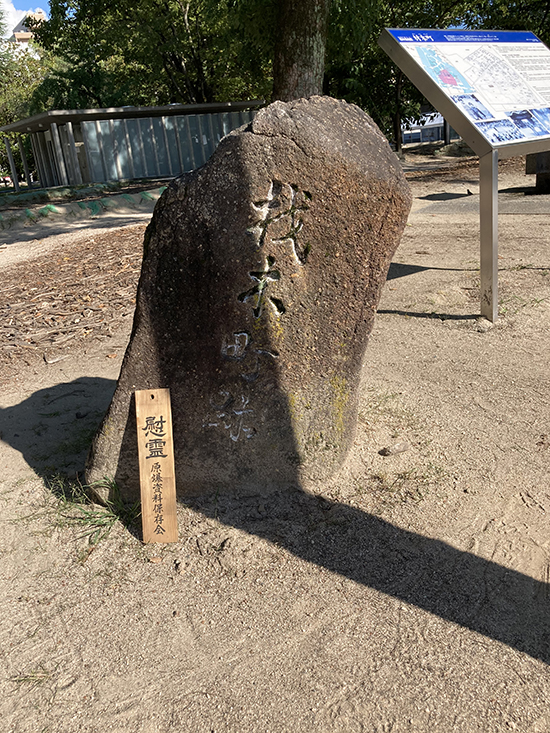
Zaimoku-cho was located to the west of Tenjinmachi. This was also a very prosperous area from the end of the Edo period to the beginning of the Showa period. There were lumber wholesalers, temples, and a peaceful downtown atmosphere. However, this area was also destroyed in an instant within 500 meters of the hypocenter, and many people were killed. After the war, this area was turned into a peace memorial park, so the name of the town disappeared and only a monument marking the location remains.
35 A-bombed Hamayu
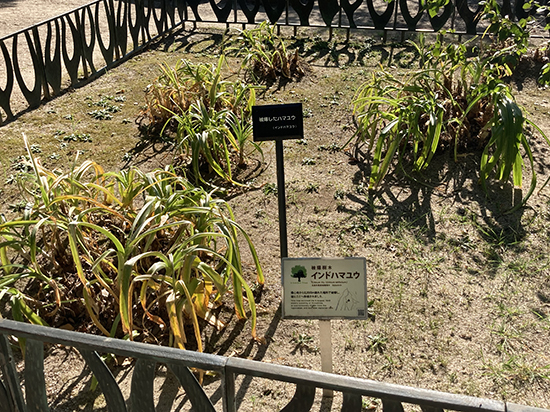
Indian Hamayu was exposed to the atomic bomb at the former Hiroshima Girls Commercial High School, 2,200 meters from the hypocenter. One month after the bombing, a former army soldier who was a barracks commander at the barracks in Hiroshima found new leaves sprouting from the burnt bulbs. He brought it back to Kamakura in Kanagawa Prefecture and grew it, and the plant is now being grown in six different locations in Japan. The A-bombed Hamayu was transplanted to Peace Memorial Park in 1969.
36 Sankichi Toge Poem Monument
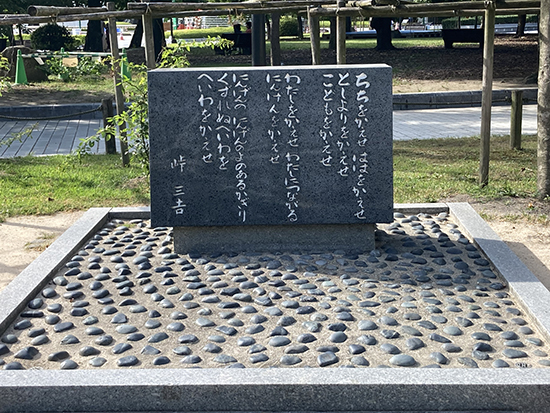
At the age of 28, poet Sankichi Toge was exposed to the atomic bombing at his home in Midori-cho, 3 km from the hypocenter. In 1950, inspired by U.S. President Truman’s remarks about the possible use of atomic bombs in the Korean War, he decided to compile a collection of his A-bomb poems. This poem, which begins with the words “Kaede chichi wo kaese, haha wo kaese,” was written as a preface to the book and is very well known. It is also known by the title “Ningen wo Kaerase” (“Give Back the Human”).
37 Monument to All Non-Life Insurance Companies
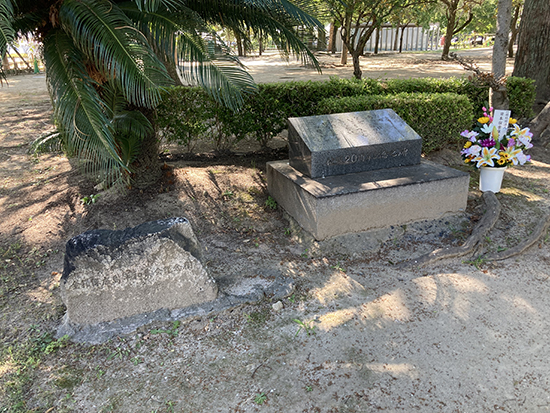
At the time, there were 14 insurance companies in Hiroshima City, employing approximately 200 people, 89 of whom were killed. The monument was erected in 1965 by the All-Life Insurance Workers Union of Hiroshima, which called for donations from all over Japan. The inscription, “Why that day, why it happened, why it continues, why I will not forget that hatred, this oath,” was written by an employee of an insurance company who was an A-bomb survivor.
38 A-Bombed Blue-Green Trees
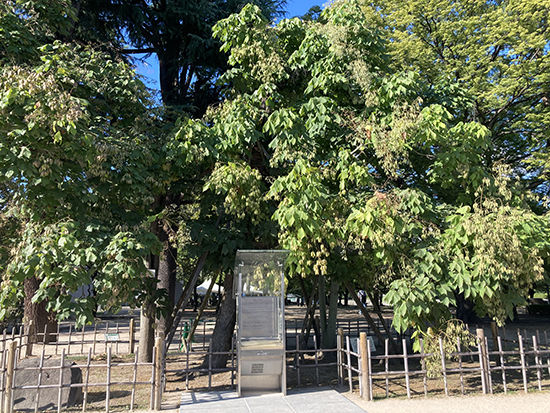
There were four aogiri trees in the building of the Hiroshima Telecommunications Bureau (former Chugoku Post Office) in Higashi-Hakushima-cho, Naka Ward, about 1.3 km from the hypocenter. One of the trees was burnt in the bombing, but the rest of the trees were almost dead, but somehow survived. The next year, the trees sprouted and gave courage to the people, but when the China Post Office was rebuilt, they were moved to their current location.
39 Pope’s Appeal for Peace Monument
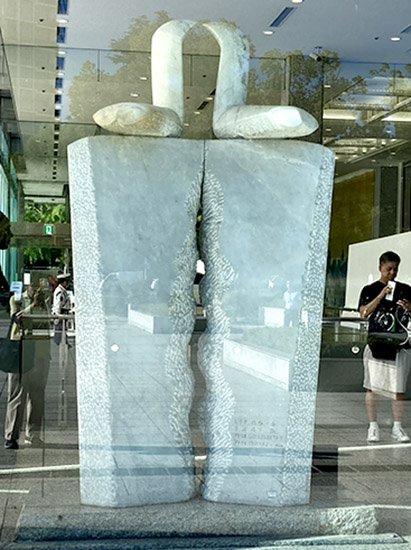
When Pope John Paul II visited Hiroshima in 1981, he impressed many people with his “Appeal for Peace” for the abolition of nuclear weapons at the welcome gathering held in Peace Memorial Park. After that, the Committee for the Erection of the Monument to the Pope’s Appeal for Peace was formed to give shape to this appeal, and the monument was completed two years later in 1983 and installed in the lobby on the first floor of Peace Memorial Hall. I did not enter the Peace Memorial Hall at the time of this interview, so this is a photo from outside (back side), but I will take another photo again.
40 Clock commemorating the return to Japan of the Democratic People’s Republic of Korea
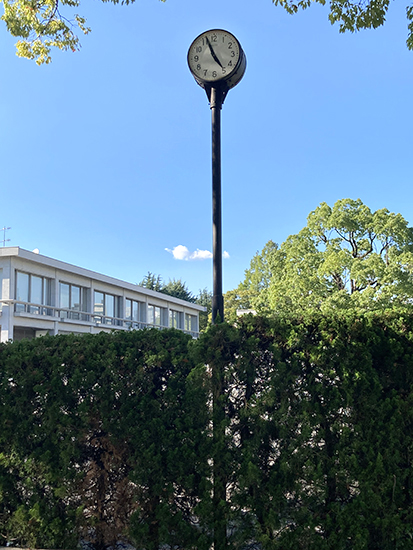
In 1959, an agreement was concluded through the Red Cross in 1959 to allow those Koreans residing in Japan who wished to return home to do so. In December of the same year, 56 people from Hiroshima Prefecture returned to Japan on the second ship and 23 people on the third ship. This clock was built mainly by those who returned to Japan to “leave a sign of DPRK-Japan friendship on Japanese soil,” and was donated to the City of Hiroshima.
41 Norman Cousins Monument
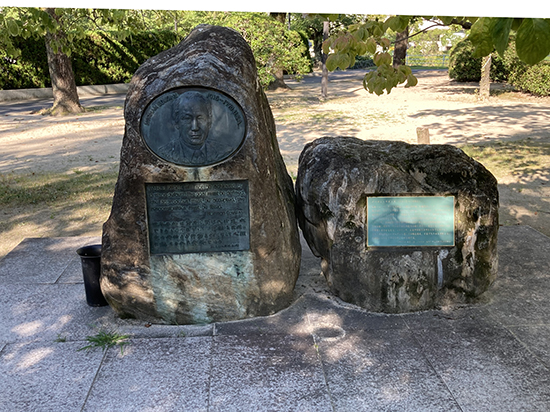
Norman Cousins, editor-in-chief of an American literary magazine, visited Hiroshima in August 1949 and published his report “Hiroshima Four Years Later. The idea of “spiritual adoption,” in which well-meaning Americans support children who have lost their parents in the atomic bombing, which he advocated there, came to fruition, and about 500 children were able to receive assistance. He also worked to ensure that women who had been exposed to the atomic bomb could receive medical treatment in the U.S. For these achievements, he was later awarded the title of Distinguished Honorary Citizen of Hiroshima.
42 Monument to Dr. Marcel Junod
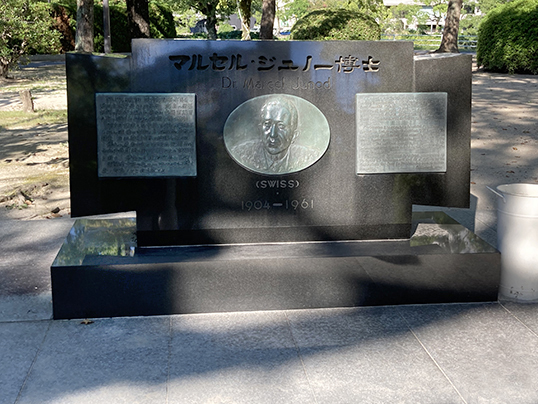
Dr. Marcel Junod was a Swiss medical doctor who came to Japan in August 1945 as a representative of the International Committee of the Red Cross. His purpose was to investigate the POWs of the Allied Forces, but as soon as he learned of the devastation caused by the atomic bombing of Hiroshima, he immediately asked GHQ (General Headquarters of the Supreme Commander of the Allied Powers) for help and entered Hiroshima with medical supplies. The monument was erected to honor Dr. Reynolds for her humanitarian efforts in providing relief and medical treatment for the atomic bomb survivors.
43 Barbara Reynolds Monument
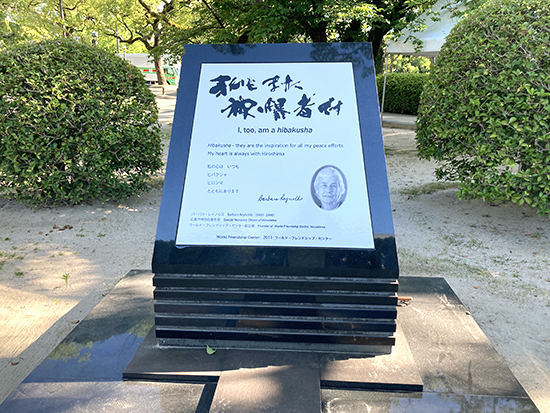
Barbara Reynolds was an American peace activist who learned about the atomic bomb damage when she and her husband, a researcher for the Atomic Bomb Casualty Commission, visited Hiroshima in 1951. Since then, Ms. Reynolds has long advocated peace and nuclear abolition in various parts of the world, including protesting the 1958 U.S. hydrogen bomb test and making the Hiroshima and Nagasaki World Peace Pilgrimage. For his achievements, he was named a special honorary citizen of Hiroshima in 1975, and this monument was erected in 2011.
44 Peace Memorial Post
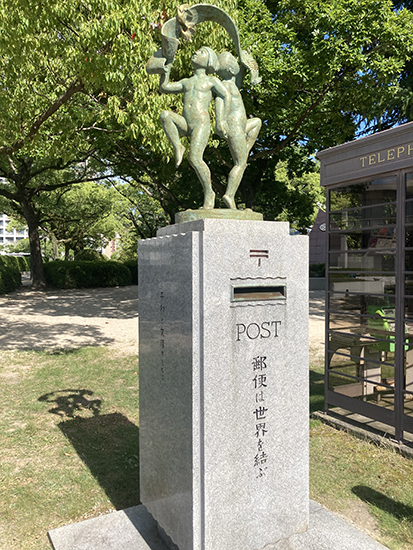
Created by sculptor Katsuzo Entsubasa, whose many memorials are located in the park. This statue depicts two people holding up a letter with their arms linked together on the theme of peace and friendship. It was created on the occasion of the “Fourth National Convention of the Postal Friendship Association” held in Hiroshima in August 1952, and was originally installed at the Hiroshima Station Post Office, but was later moved to Peace Memorial Park. This post box is still in use today.
45 Peace Tower
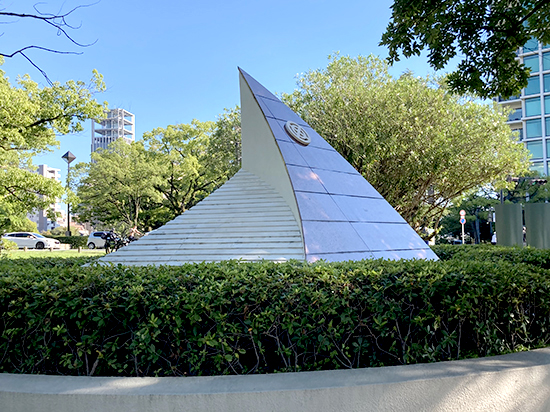
The Peace Tower was built in 1974 to commemorate the 20th anniversary of Hiroshima’s declaration as a World Federal City. The World Federation City Declaration is an expression of support for the World Federation Movement by local governments, in which they express their support for the preciousness of peace. The pentagonal pyramid is 4 meters on each side and has a unique shape with gently curling edges.
46 Hiroshima Municipal High School for Girls Cenotaph for the A-bomb Victims
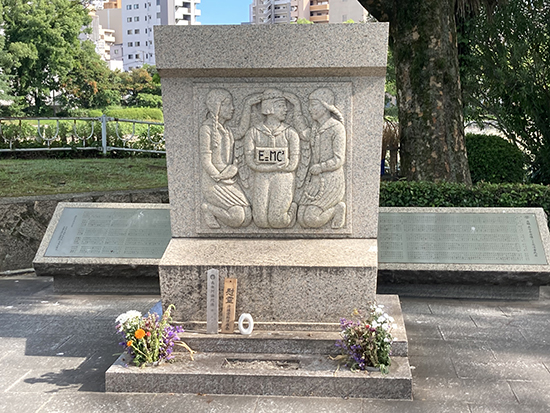
At Hiroshima Municipal High School for Girls (now Hiroshima Municipal Funairi High School), 541 first and second year students and 10 staff members who had come to Zaimoku-cho and Kobiki-cho, approximately 500 meters from the hypocenter, to evacuate buildings were killed by the atomic bomb (676 people from the school, including those from other locations, died). The original memorial tower was replaced by the present cenotaph, which was erected in 1948 on a grassy hill at the site of the school’s dedication hall. The design depicts a young girl in the center protected by her friends on either side.
47 Cenotaph for the Former Tenjincho Minamigumi
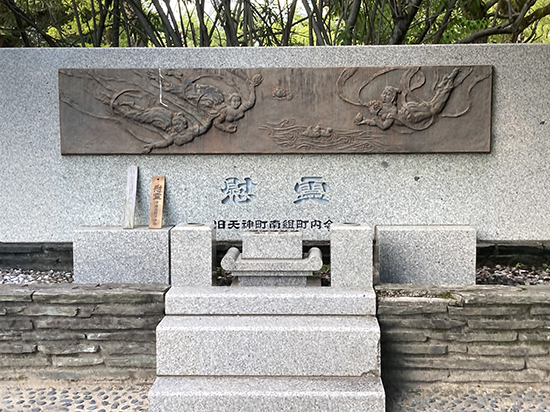
Although the area is now Peace Memorial Park, there was a town called Tenjinmachi that stretched vertically along the west side of the Motoyasu River and was very bustling. It was very close to the hypocenter, and almost all the houses in Tenjin-cho were completely destroyed and burned down by the atomic bomb, and almost 100% of the people died immediately. Tenjincho was divided into the North and South clans near the current Heiwa Ohashi Bridge, and in 1973, a monument was erected to commemorate the victims of the South clan at the site where the South clan once stood.
F East bank of Motoyasu River 1 (south side of Motoyasu Bridge)
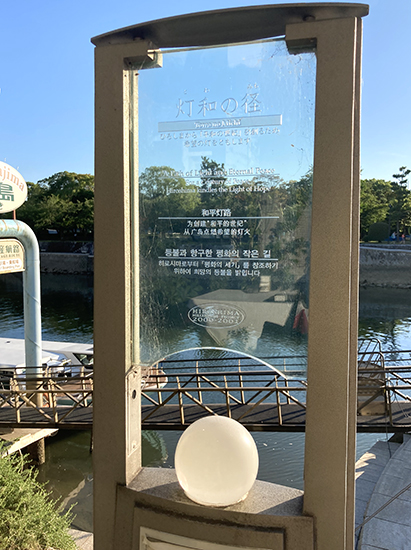
48 Monument for Hiroshima Post Office employees killed in the line of duty
49 Peace Memorial
50 Monument for Construction Workers and Craftsmen Victims of the Atomic Bomb
51 Peace Prayer Phrase Monument
52 Monument to the Atomic Bomb Victims of Hiroshima
53 Monument in memory of Hiroshima Gas Co.
54 Memorial to the victims of the atomic bombing related to coal
48 Monument for Hiroshima Post Office employees killed in the atomic bombing
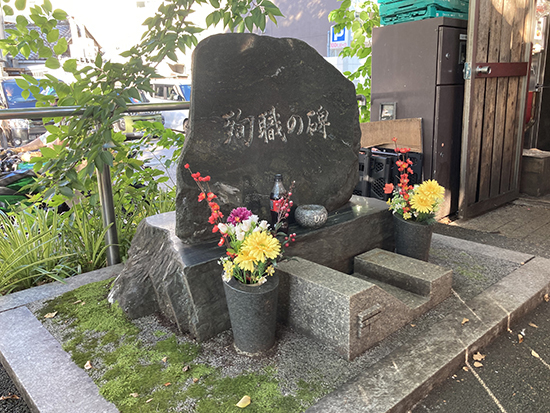
The former Hiroshima Post Office had been operating as the center of postal services in Hiroshima since 1871, but because it was located right next to the Island Hospital, the hypocenter, the building was instantly destroyed by the high heat and shock, and the 288 people inside are thought to have died instantly. Many of the victims were female students and students of the National School to make up for the lack of manpower. This monument was created to commemorate the victims and to remember the site of the post office. The location is a little difficult to find, but it is behind a store that sells juice and other products (on the side of the road).
49 Peace Memorial
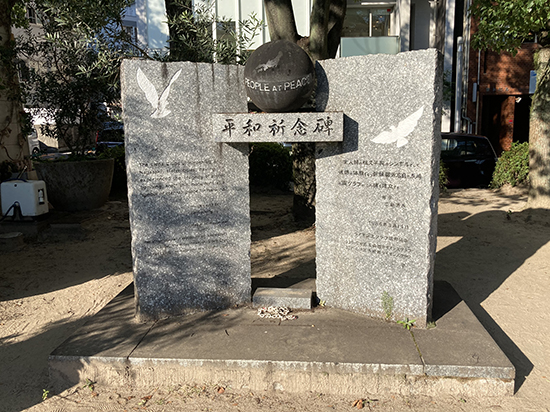
The Peace Monument was erected in 1984 to commemorate the sisterhood between the Hiroshima Nishi Lions Club and the Nagasaki Nishi Lions Club in 1982, and monuments of the same design were erected in both Hiroshima and Nagasaki (Nagasaki is in Hiranomachi, Nagasaki City). It is a commemoration of the conclusion of the sisterhood as well as a wish to serve as a symbol of lasting peace for all mankind.
50 Monument to Construction Workers and Craftsmen Victims of the Atomic Bomb
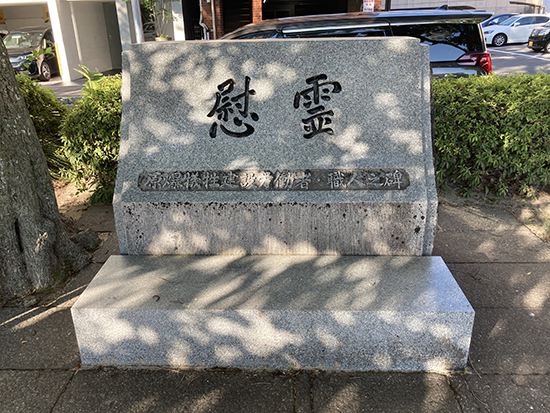
This monument was erected on August 5, 1988 by the National Federation of Construction Workers’ Unions (Zenken Soren) and the Hiroshima Prefecture Construction Workers’ Union to commemorate the victims of the atomic bombing and their families, as well as to vow that no such victims should be made in the future. On August 8 of the same year, Zenkokuren also erected a cenotaph in Nagasaki City.
51 Prayer for Peace Phrase Monument
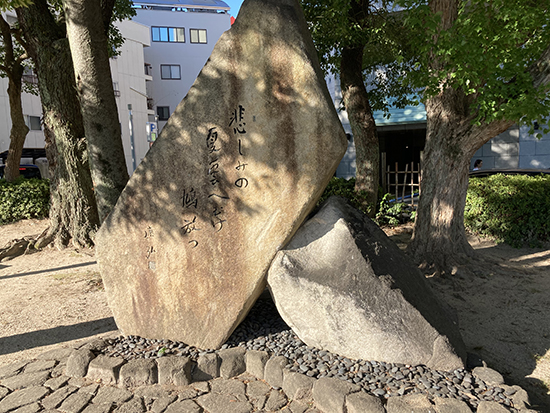
Erected in 1987. The monument is built on a paving stone in the shape of a human being, and is inscribed with a haiku by former Prime Minister Yasuhiro Nakasone, “Sadness in the summer, release a dove to the clouds”. This haiku was composed by Nakasone when he attended the Peace Memorial Ceremony in 1983, and is said to express his desire to convey to future generations the suffering and pain of those whose lives were cut short by the atomic bombing.
52 Atomic Bomb Victims of Hiroshima Monument
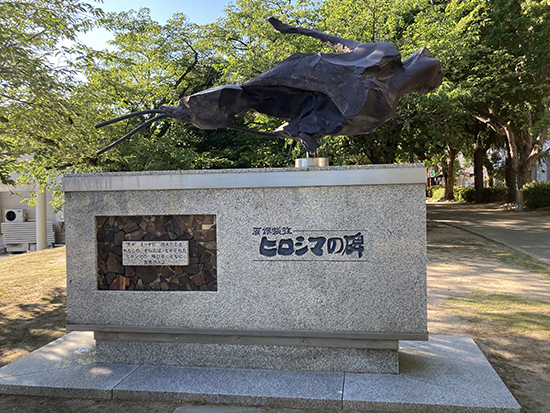
Many tiles whose surfaces had been destroyed by the atomic bomb and melted were buried in the bed of the Motoyasu River. Since 1977, high school students of the Hiroshima High School Peace Seminar, who had been studying peace in this area, dug up several thousand of these tiles and repeated the suffering of the victims. In 1981, in conjunction with the beautification of the area, the high school students proposed a cenotaph made of these tiles, and the inscription was chosen by the students and erected in 1982. The bronze statue above represents the souls of the victims.
53 Hiroshima Gas Monument in Memory of Atomic Bomb Victims
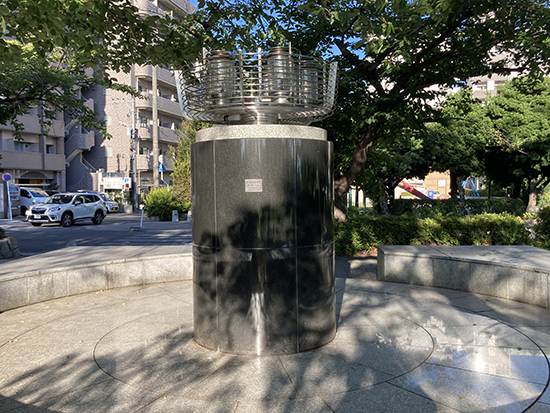
The headquarters of Hiroshima Gas (now Hiroshima Gas) used to be located here. Only 250 meters from the hypocenter, the reinforced concrete and brick building with three stories above ground and one below collapsed into pieces, killing 35 people, including employees and executives of gas companies in other prefectures. Today, a cylindrical monument made of black granite, approximately 2 meters high and 1 meter in diameter, was built on the site, and five gas lamps are lit on its base.
54 Cenotaph for Coal-related A-bomb Victims
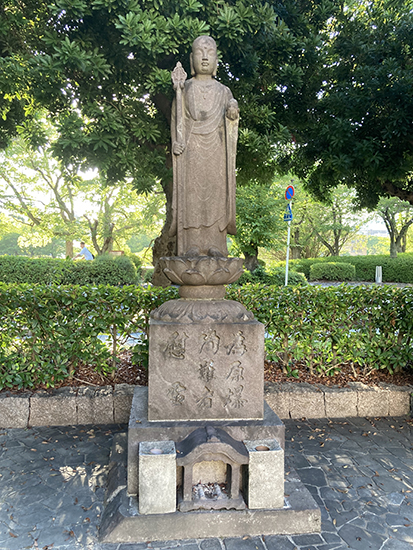
This monument was erected to pray for the repose of the souls of the employees of three coal control-related companies; all but one of the 77 employees of the three companies were killed. This cenotaph is in the form of a stone Jizo, commonly called “Atomic Bomb Jizo-san”. All other monuments in this area are located on the banks of the Motoyasu River, but this monument is in the park across the Motoyasu River (Otemachi Daiichi Park). Please note that you need to cross the road.
G Motoyasu River East Bank 2 (near Heiwa Ohashi Bridge)
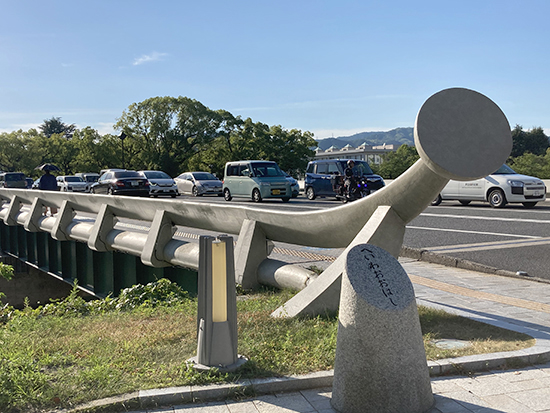
55 Hiroshima Prefecture Agricultural Association Cenotaph for the A-bomb Victims
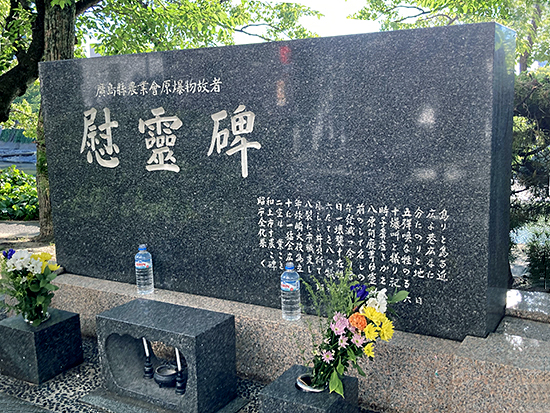
In 1945, the Hiroshima Prefectural Agricultural Association had a Hiroshima branch office where the cenotaph stands today, and its main office 700 meters southeast of the Hiroshima City Hall. Both were reduced to ruins by the atomic bombing, and more than 80 people, including employees and branch office directors who were working on the day of the bombing, were killed in an instant. The monument is 1 meter high and 2 meters wide, made of black lizard stone, and was erected in 1970. The names of 83 victims, including those who later died of A-bomb diseases, are engraved on the back of the monument.
56 Hair Monument
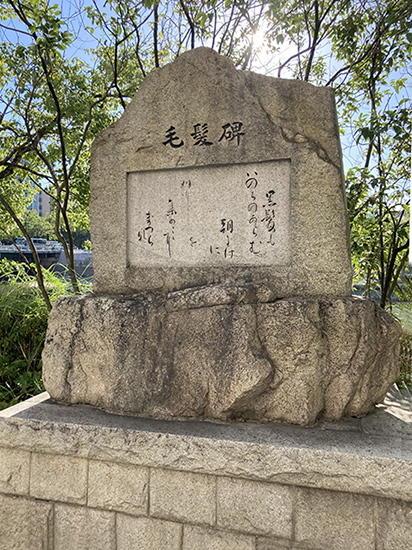
The hair monument has nothing to do with the atomic bombing, but was erected in 1960 by the Hiroshima City Barbers Association as a symbol of appreciation for the improvement and development of barbering techniques. If this were the case, it would not be appropriate to include it in this article, but it is located alongside the area, and in some aspects it reminds us of the hair of the many female students who were killed in the atomic bombing, so we think it would be appropriate to visit the monument together.
57 Statue of Jibo Kannon (Goddess of Mercy) for A-bombed mobilized students
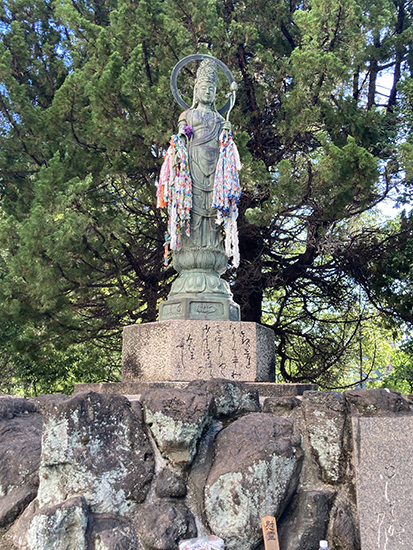
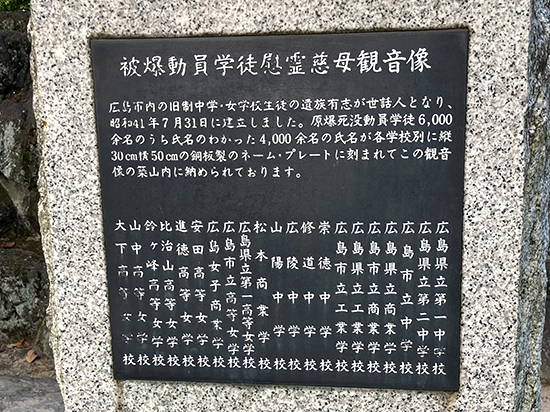
The Kannon (Goddess of Mercy) stands a little further south along the Motoyasu River and beyond Peace Boulevard. This is a memorial to the students of 21 former junior high schools and girls’ schools in Hiroshima City. In accordance with the School Cadets’ Labor Ordinance issued in August of the previous year, more than 8,200 students from national high schools, junior high schools, and girls’ schools were mobilized for building evacuation work in Hiroshima City in August 1945 as well, and approximately 6,300 of them died as a result of the atomic bombing. The names of approximately 4,000 students who sacrificed their lives are engraved on name plates on this monument, which is housed in the Tsukuyama.
Description of Major Buildings and Statues
Below is a brief description of the main buildings and statues in Peace Memorial Park.
Atomic Bomb Dome
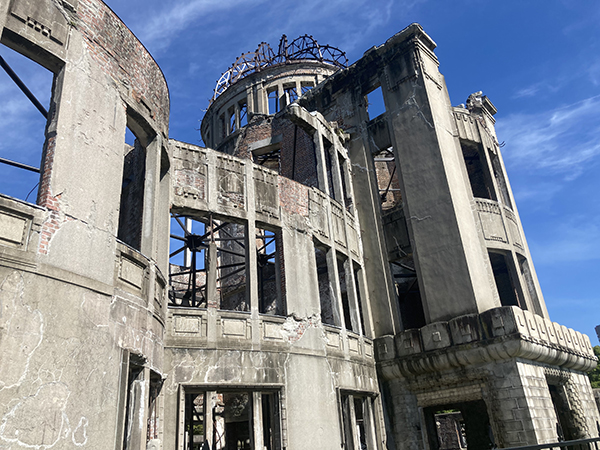
Needless to say, the Atomic Bomb Dome is the symbolic structure that best conveys the horror of the atomic bombing and is a UNESCO World Heritage Site (cultural heritage). Originally called the Hiroshima Prefectural Industrial Promotion Hall, it was completed in 1915 and was a bustling place for displaying the diverse products of Hiroshima Prefecture. The design by Czech architect Jan Retzel was also excellent, and the building was highly regarded as a building. Although there are some problems such as earthquakes, the building continues to be preserved in its current state while conservation work is being done.
Cenotaph for the Atomic Bomb Victims
The Cenotaph for the Atomic Bomb Victims is the centerpiece of Peace Memorial Park and is officially named “Hiroshima Peace City Memorial.
Those who died as a result of the atomic bombing and subsequent exposure to radiation are added to the “List of the Atomic Bomb Victims” and placed in a sarcophagus in the center of the monument.
The inscription, “Rest in peace, for I will not repeat my mistake,” was written by the late Professor Tadayoshi Saiga of Hiroshima University. I remember that there was much debate over the subject of “Never Repeat”, but the interpretation of the inscription has been settled as “As the feeling of all people, we pledge not to repeat the mistakes of war and wish for peace”.
Peace Lamp
The Peace Light was erected on August 1, 1964. It was designed by Kenzo Tange. On that day, “religious fires” from 12 religious sects across Japan and “industrial fires” from industrial areas across Japan were transferred and lit here. Since then, it has been kept burning, and will continue to be lit with the intention of “keeping it burning until all nuclear weapons are eliminated from the world. In conjunction with the erection of the Peace Lamp, the surrounding pond, “Peace Pond,” was also expanded.
Statue of the Children of the Atomic Bomb
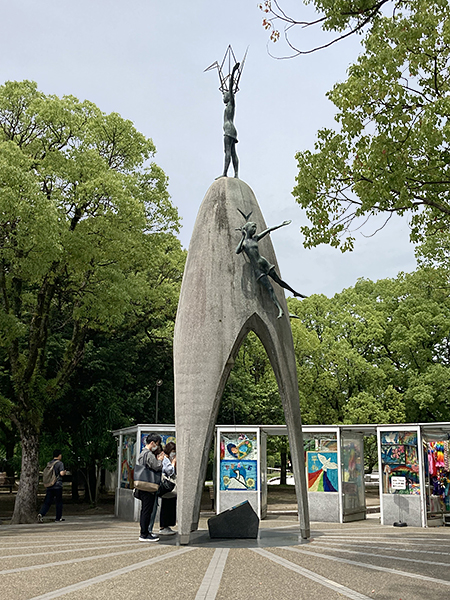
The Children of the Atomic Bomb statue was created in memory of Sadako Sasaki, who died of leukemia from the atomic bombing at the age of only 12, with donations from all over Japan. It is also called the “Tower of a Thousand Paper Cranes” because Sadako folded paper cranes to pray for her recovery.
The tower is also a symbol of peace and a statue to comfort the spirits of the children who died in the atomic bombing, including Teiko.
Origami cranes from all over the world have been donated to the Children of the Atomic Bomb Statue. After the paper cranes are hung on the statue, they are carefully stored in this space.
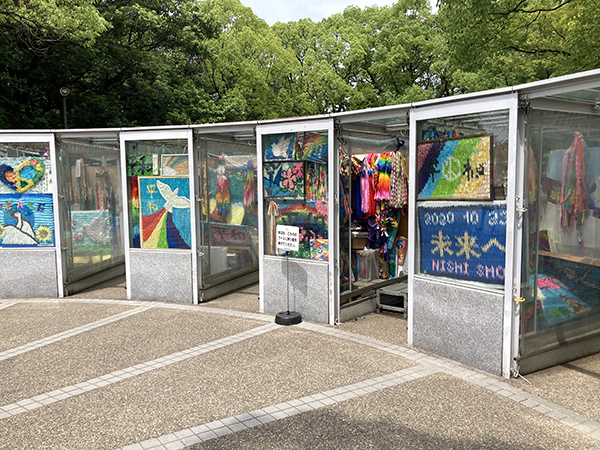
Rest House
The Rest House was originally built in 1929 as a kimono store called Taishoya. It is one of the so-called “A-bombed buildings” that remained despite its proximity to the hypocenter. Visitors can take a rest here, of course, but there are also people in charge of tourist information and various souvenirs for sale.
In the exhibition rooms on the first and third basement floors, there are displays of testimonies from survivors and a diorama of the former Nakajima-cho where this facility is located, and in the cafe on the second floor, there is a display of A-bombed pianos.
Peace Memorial Museum Main and East Wings
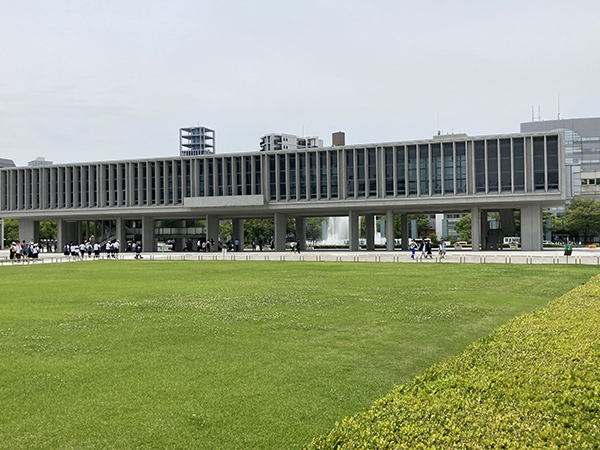
Since its opening in 1955, the Peace Memorial Museum has undergone major renovations, including earthquake reinforcement, from 2017 to 2019, although it was only renovated in 1991.
The entrance is in the East Wing. The East Wing contains exhibits about Hiroshima before and after the atomic bombing, a computer graphics of the city at the moment of the bombing, a video of Hibakusha testimonies, and an exhibit about the threat of nuclear weapons.
The Main Wing is entered from the East Wing through a corridor. The museum exhibits many items left behind by A-bomb survivors, as well as photographs and paintings that illustrate the tragedy of the atomic bombing. Compared to the East Wing, the “reality of the atomic bombing” is more deeply understood here.
On Saturdays and Sundays, there is always a long line at the entrance. Although this may be unavoidable for the safety of visitors and for the proper viewing of the exhibits, I personally feel that something more could be done.
- Opening Hours
-
March – July / 8:30-18:00
August / 8:30-19:00 (until 20:00 on August 5 and 6)
September – November / 8:30-18:00
December – February / 8:30-17:00 - Days closed
-
Dec. 30 and Dec. 31 *The Information Resource Room is closed from Dec. 29 to Jan. 1.
Exhibition changeover period: February (3 days from the middle of the month)
- Admission
-
Adults (college students and older) 200 yen (160 yen per person for groups of 30 or more)
High school students 100 yen (free for groups of 20 or more)
Junior high school students and younger free
Cashless payment accepted -
For more information, please visit the official website of Hiroshima Peace Memorial Museum.
International Conference Hall
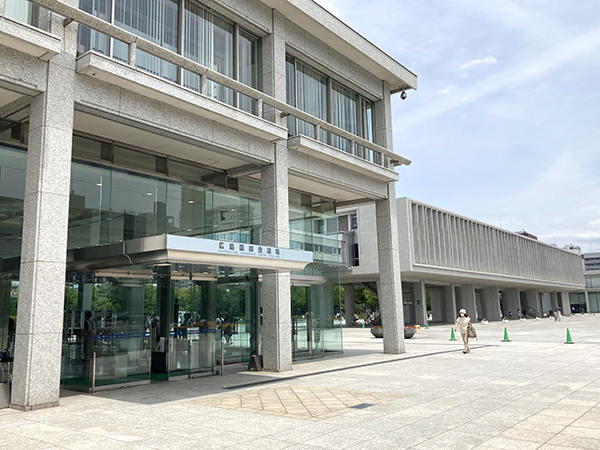
This facility was originally called the Hiroshima City Public Hall, but was later rebuilt into the current one in 1989 and renamed the Hiroshima International Conference Center. It has a Phoenix Hall that can accommodate approximately 1,500 people, an International Conference Hall, and large and small conference rooms, and is used for international conferences with representatives from around the world, concerts, large and small lectures, and other events.
Hiroshima National Peace Memorial Hall for the Atomic Bomb Victims
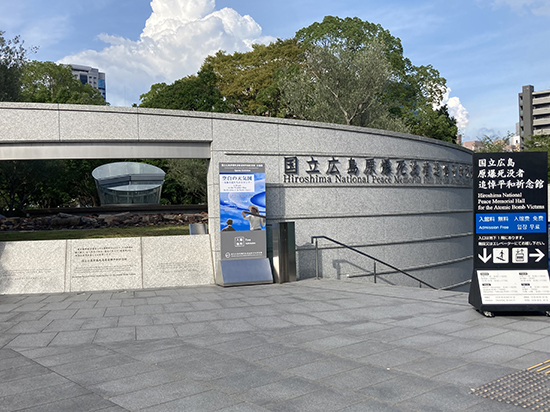
The Hiroshima National Peace Memorial Hall for the Atomic Bomb Victims was the first national facility built in Hiroshima Peace Memorial Park in August 2002. It was designed by Kenzo Tange. The entrance is on the basement level, and the facility is located on the first and second basement levels.
The first basement level contains an information exhibition area and a room for reading accounts of the atomic bombing, while the second basement level contains a space for praying for peace, a memorial space for the dead, and a place to view the remains of the dead.
In order to convey the facts of the devastation caused by the atomic bombings and to pass on the importance of life and the preciousness of peace, the museum collects, organizes, and displays the names and photos of the dead and their families, as well as their memoirs and videos of their experiences, and holds special exhibitions and readings of A-bomb accounts from time to time.
- Hours of operation
-
March – July / 8 : 30-18 : 00
August / 8 : 30-19 : 00 (until 20 : 00 on August 5 and 6)
September – November / 8: 30-18:00
December – February / 8:30-17:00 - Days closed
-
December 30 and December 31
- Admission
-
Free of charge
A-bomb Remains Exhibition Hall
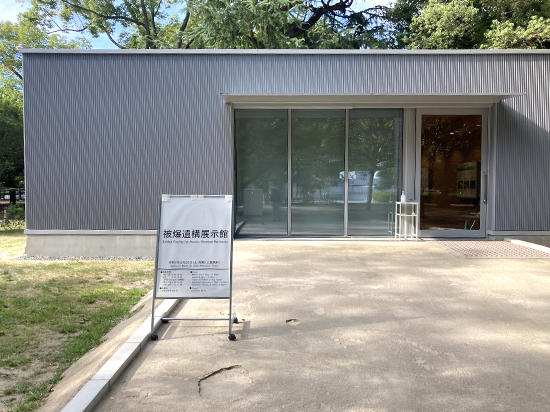
The Atomic Bomb Survivors Exhibition Hall is a relatively new facility that opened in March 2022. It was built by the City of Hiroshima with the hope that visitors to Hiroshima Peace Memorial Park will learn, through the A-bomb remains, that there used to be a town where many people lived, and that their daily lives were taken away in an instant by a single atomic bomb.
The stone materials bordering neighboring houses, the gutters through which domestic wastewater would have flowed, replicas of carbonized tatami mats, and other replicas of actual or deteriorating items are displayed in their original state, giving visitors a very realistic picture of life at the time of the bombing and the conditions of exposure. Please visit this museum as well as the Peace Memorial Museum.
- Opening Hours
-
March – July / 8 : 30-18 : 00
August / 8 : 30-19 : 00 (until 20 : 00 on August 5 and 6)
September – November / 8: 30-18:00
December – February / 8:30-17:00 - Days closed
-
December 30 and December 31
- Admission
-
Free of charge
At the end
I have described the locations and descriptions of the cenotaphs, memorial towers, and statues in and around Hiroshima Peace Memorial Park, as well as the main facilities.
After all, when I am in this place, words like “peace” and “everyday life” are spreading in my mind.
We have many visitors, including junior high and high school students, families, and people from overseas, and I am sure that peace will be engraved in the hearts of all of you once again.
Please come and join us. I hope you will come and think about what peace, war, and daily life are all about.
Here is a list of articles related to Hiroshima on this blog. You can jump to each article from here, including sightseeing spots in Hiroshima, if you like.
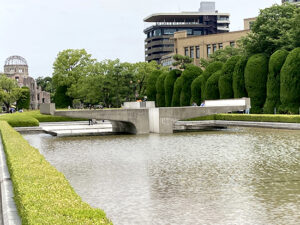
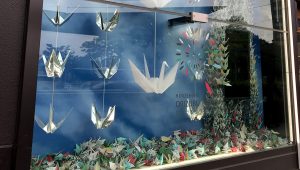

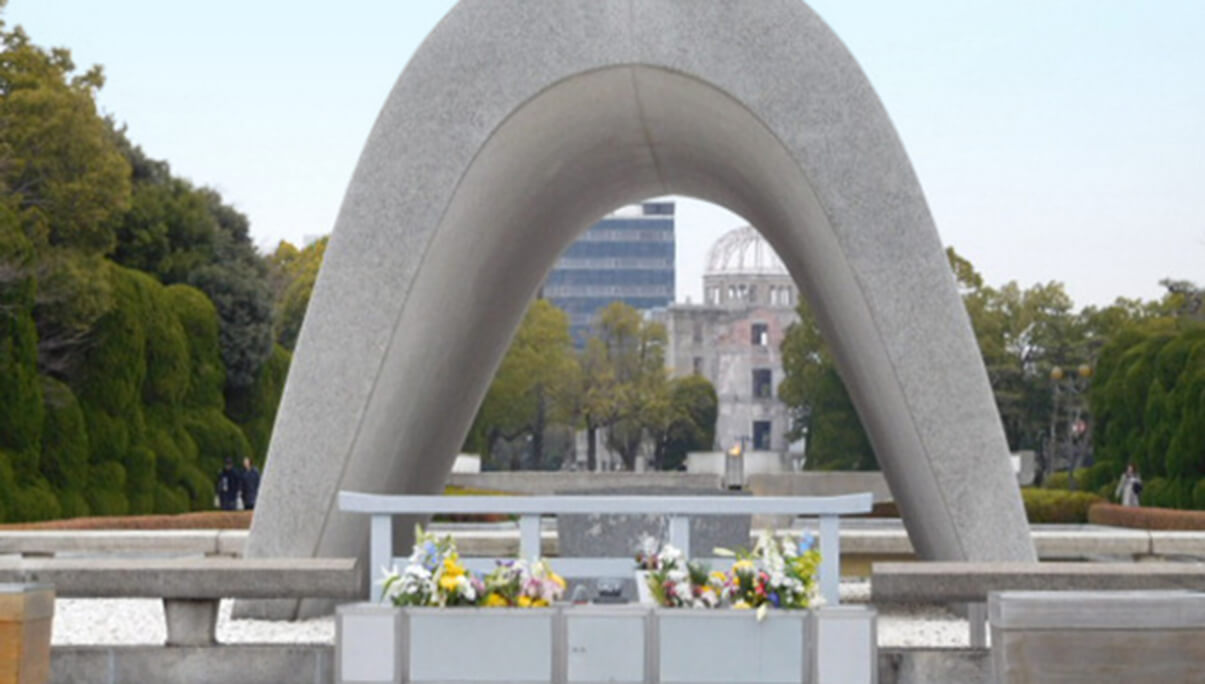
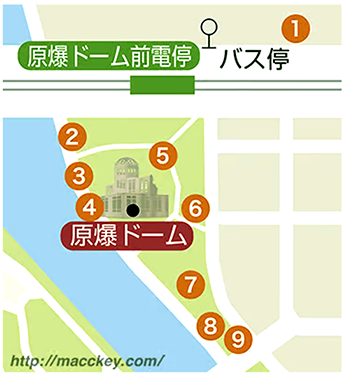
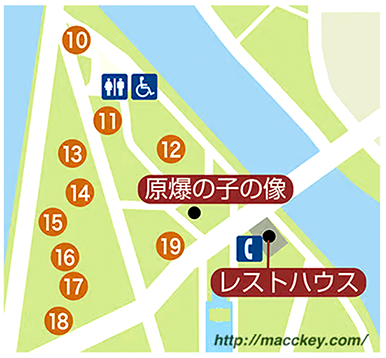
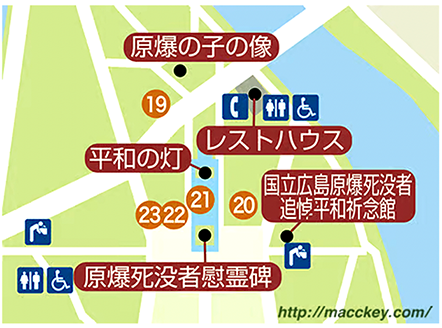
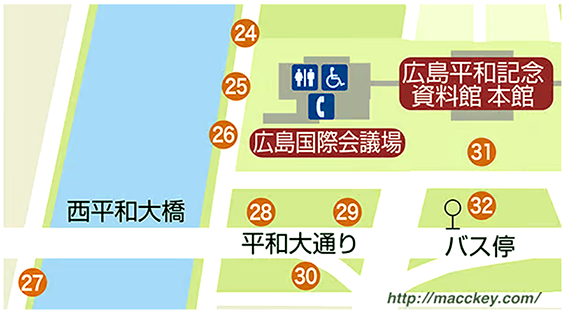
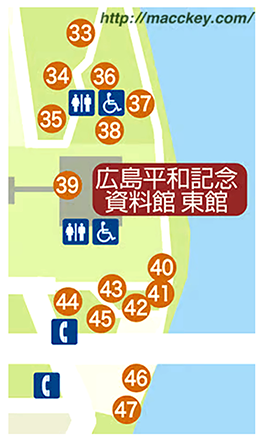
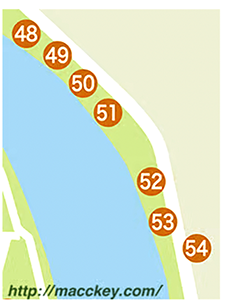
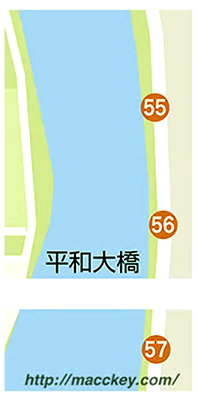
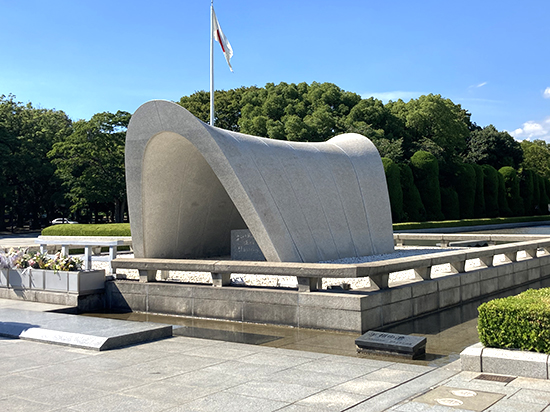
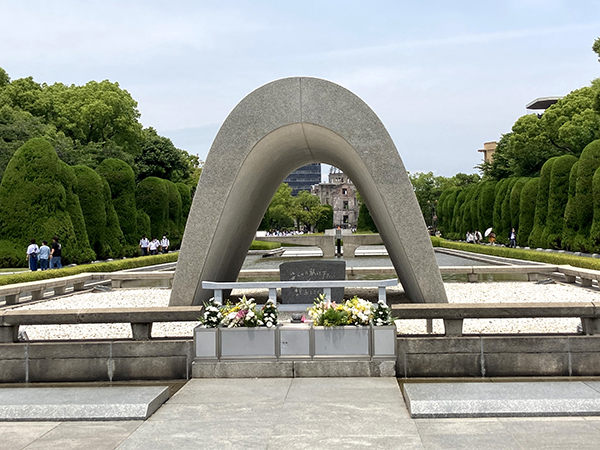
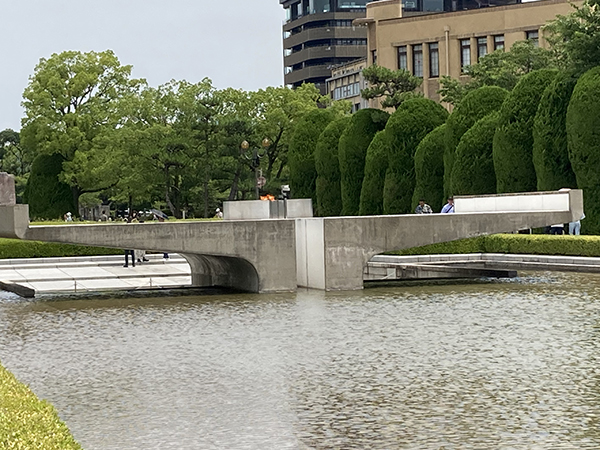
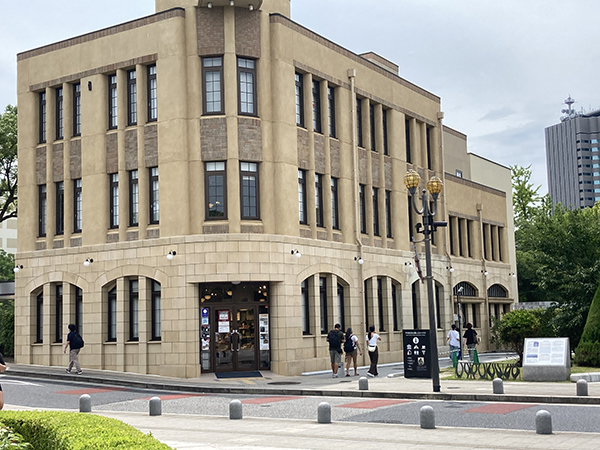
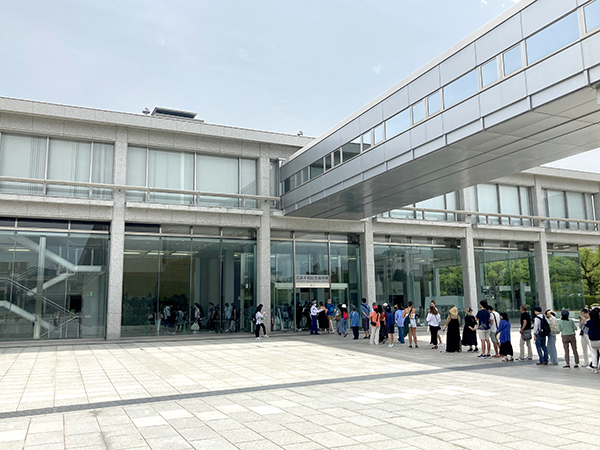
Comments